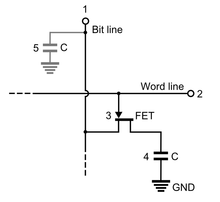

The memory cell is the fundamental building block of memory. The memory cell stores one bit of binary information and it must be set to store a 1 and reset to store a 0. Its value is maintained/stored until it is changed by the set/reset process. The value in the memory cell can be accessed by reading it.
On December 11, 1946 Freddie Williams applied for a patent on his cathode-ray tube (CRT) storing device (Williams tube) with 128 40 bit words, it was operational in 1947 and it's considered to be the first practical implementation of random-access memory. In that year, the first patents for magnetic-core memory are filed by Frederick Viehe, An Wang, Ken Olsen and Jay Forrester also contributed to its development. In 1969 John Schmidt designs the first 64-bit MOS p-channel SRAM. The first bipolar 64-bit SRAM is released by Intel in 1969 with the 3101 Schottky TTL and one year later it releases the first DRAM chip, the Intel 1103.
The memory cell is the fundamental building block of memory. It can be implemented using different technologies, such as: bipolar, MOS, and other semiconductor devices, it can also be built from magnetic material such as ferrite cores or magnetic bubbles. Regardless of the implementation technology used, the purpose of the binary memory cell is always the same. It stores one bit of binary information and it must be set to store a 1 and reset to store a 0. [1]
In the following schematics detail the three most used implementations nowadays for memory cells :
 |
 |
 |
Logic circuits without memory cells or feedback paths are called combiantional, their outputs values depend only on the current value of their input values. They do not have memory. But memory is a key element of digital systems. In computers it allows to store both programs and data. and memory cells are also used for temporary storage of the output of combinational circuits to be used latter by digital systems. Logic circuits that use memory cells are called sequential circuits. Its output depends not only on the present value of it's inputs, but also on the circuits previous state, as determined by the values stored on is memory cells. This circuits require a timing generator or clock for their operation.[2]
Computer memory used in computer systems is built mainly out of DRAM cells, since the layout is much smaller than SRAM, it can be more densly packed yielding cheaper memory with greater capacity. Since the DRAM memory cell stores its value as the charge of a capacitor, and there are current lickeage issues, its value must be constantly rewriten. this is one of the reasons that make DRAM cells slower than the larger SRAM (Static RAM) cells, which has its value always availble. That is the reason why SRAM memory is used for on chip Cache memory included in modern microprocessor chips. [3]